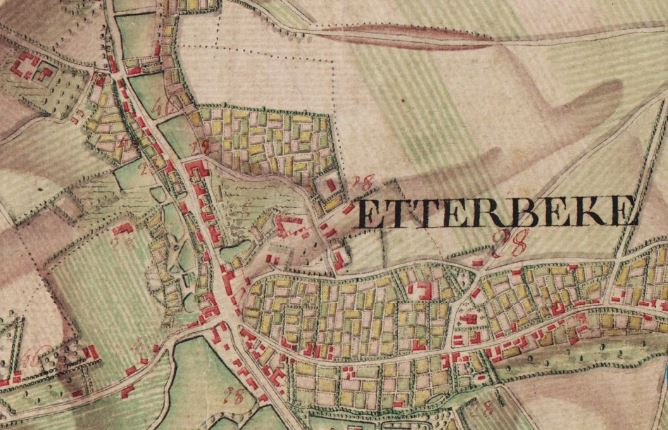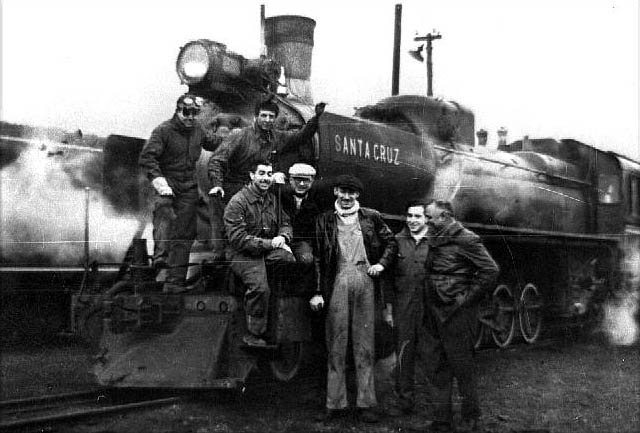|
Maurice Lemaître (mechanical Engineer)
Maurice Lemaître (Maurice Édouard Jean Joseph Ghislain Lemaître; born Charleroi, 6 July 1898; died Etterbeek 25 December 1974) was a Belgian mechanical engineer who developed a steam locomotive exhaust system first used by the Nord-Belge railway company, a subsidiary of the French-owned Chemins de Fer du Nord. The Lemaître exhaust (''échappement Lemaître'') – which featured a blastpipe with five nozzles in a circular pattern exhausting up a large-diameter chimney, plus a variable-area nozzle exhausting up the centre – produced an efficiency gain of around 10%. The design was later improved by the Argentine engineer Livio Dante Porta, who devised the Lempor (a portmanteau A portmanteau word, or portmanteau (, ) is a blend of words [...More Info...] [...Related Items...] OR: [Wikipedia] [Google] [Baidu] |
Charleroi
Charleroi ( , , ; wa, Tchålerwè ) is a city and a municipality of Wallonia, located in the province of Hainaut, Belgium. By 1 January 2008, the total population of Charleroi was 201,593.Statistics Belgium; ''Population de droit par commune au 1 janvier 2008'' (excel-file) Population of all municipalities in Belgium, as of 1 January 2008. Retrieved on 19 October 2008. The metropolitan area, including the outer commuter zone, covers an area of with a total population of 522,522 by 1 January 2008, ranking it as the 5th most populous in |
Etterbeek
Etterbeek ( French: ; Dutch: ) is one of the 19 municipalities of the Brussels-Capital Region, Belgium. Located in the eastern part of the region, it is bordered by the municipalities of Auderghem, the City of Brussels, Ixelles, Schaerbeek, Woluwe-Saint-Lambert and Woluwe-Saint-Pierre. In common with all of Brussels' municipalities, it is legally bilingual (French–Dutch). The main university campus of Vrije Universiteit Brussel (VUB) is called ''Campus Etterbeek'', although it is geographically not within Etterbeek but in the adjacent Ixelles. History Origins and etymology According to legend, Saint Gertrude of Nivelles, daughter of Pippin of Landen, founded a chapel there in the 8th century. A document by Holy Roman Emperor Otto I, dated 966, mentions the church of ''Iatrebache''. The name ''Ietrebecca''—possibly from the Celtic root ''ett'' meaning "rapid movement" and the Dutch word ''beek'' meaning "stream"—is found for the first time in a document dated 1127. The cur ... [...More Info...] [...Related Items...] OR: [Wikipedia] [Google] [Baidu] |
Belgians
Belgians ( nl, Belgen; french: Belges; german: Belgier) are people identified with the Kingdom of Belgium, a federal state in Western Europe. As Belgium is a multinational state, this connection may be residential, legal, historical, or cultural rather than ethnic. The majority of Belgians, however, belong to two distinct ethnic groups or ''communities'' ( nl, gemeenschap, links=no; french: communauté, links=no) native to the country, i.e. its historical regions: Flemings in Flanders, who speak Dutch; and Walloons in Wallonia, who speak French or Walloon. There is also a substantial Belgian diaspora, which has settled primarily in the United States, Canada, France, and the Netherlands. Etymology The 1830 revolution led to the establishment of an independent country under a provisional government and a national congress. The name "Belgium" was adopted for the country, the word being derived from ''Gallia Belgica'', a Roman province in the northernmost part of Gaul that, ... [...More Info...] [...Related Items...] OR: [Wikipedia] [Google] [Baidu] |
Steam Locomotive Exhaust System
The steam locomotive exhaust system consists of those parts of a steam locomotive which together discharge exhaust steam from the cylinders in order to increase the draught through the fire. It usually consists of the blastpipe (or first stage nozzle), smokebox, and chimney, although later designs also include second and third stage nozzles. History The primacy of discovery of the effect of directing the exhaust steam up the chimney as a means of providing draft through the fire is the matter of some controversy, Ahrons (1927) devoting significant attention to this matter. The exhaust from the cylinders on the first steam locomotive – built by Richard Trevithick – was directed up the chimney, and he noted its effect on increasing the draft through the fire at the time. At Wylam, Timothy Hackworth also employed a blastpipe on his earliest locomotives, but it is not clear whether this was an independent discovery or a copy of Trevithick's design. Shortly after Hackworth, Geor ... [...More Info...] [...Related Items...] OR: [Wikipedia] [Google] [Baidu] |
Chemins De Fer Du Nord
The Chemins de fer du Nord at National Railway Museum website. Retrieved 28 July 2013 (french: Compagnie des chemins de fer du Nord or ''CF du Nord''), ( en, Northern Railway Company) often referred to simply as the Nord company, was a company, created in , , in September 1845. It was owned by, among others, |
Lemaître Exhaust
The Lemaître exhaust is a type of steam locomotive exhaust system developed by the Belgian engineer Maurice Lemaître. Construction The Lemaître exhaust featured a blastpipe with 5 nozzles in a circular pattern exhausting up a large-diameter chimney stack, with a variable area nozzle exhausting up the centre, and improved efficiency by about 10%. Uses The Lemaître exhaust was used extensively in Great Britain by OVS Bulleid on his new locomotive designs for the Southern Railway, namely the Merchant Navy, Light Pacific and Q1 classes. Bulleid also retro-fitted Lemaître exhausts on some older classes, such as the SR Lord Nelson class and some of the SR V Schools class. Further Development The design was later improved by Livio Dante Porta, who created the Lempor The Lempor ejector is a steam locomotive exhaust system developed by noted Argentina, Argentine locomotive engineer Livio Dante Porta. The ejector's name is a portmanteau of the names of Porta and Belgian locomoti ... [...More Info...] [...Related Items...] OR: [Wikipedia] [Google] [Baidu] |
Blastpipe
The blastpipe is part of the exhaust system of a steam locomotive that discharges exhaust steam from the cylinders into the smokebox beneath the chimney in order to increase the draught through the fire. History The primacy of discovery of the effect of directing the exhaust steam up the chimney as a means of providing draft through the fire is the matter of some controversy, Ahrons (1927) devoting significant attention to this matter. The exhaust from the cylinders on the first steam locomotive – built by Richard Trevithick – was directed up the chimney, and he noted its effect on increasing the draft through the fire at the time. At Wylam, Timothy Hackworth also employed a blastpipe on his earliest locomotives, but it is not clear whether this was an independent discovery or a copy of Trevithick's design. Shortly after Hackworth, George Stephenson also employed the same method, and again it is not clear whether that was an independent discovery or a copy of one of the other ... [...More Info...] [...Related Items...] OR: [Wikipedia] [Google] [Baidu] |
Livio Dante Porta
Livio Dante Porta (21 March 1922 – 10 June 2003) was an Argentine steam locomotive engineer. He is particularly remembered for his innovative modifications to existing locomotive systems in order to obtain better performance and energy efficiency, and reduced pollution. He developed the Kylpor and Lempor exhaust systems. The Lemprex was under development at the time of his death. Early years Porta was born in Paraná, Entre Ríos, and studied civil engineering, concluding his studies in 1946, at a time when steam was already giving way to diesel and electric locomotives in Europe and North America. Career Naturally, Porta's first projects were in Argentina. Taking the work of Andre Chapelon in France as his starting point, he set out to demonstrate that the steam locomotive was far from reaching its maximum potential. His first locomotive project in 1948 took the remains of a 4-6-2 converting it into a 4-cylinder compound 4-8-0 named 'Presidente Peron'/'Argentina'. T ... [...More Info...] [...Related Items...] OR: [Wikipedia] [Google] [Baidu] |
Lempor Ejector
The Lempor ejector is a steam locomotive exhaust system developed by noted Argentine locomotive engineer Livio Dante Porta. The ejector's name is a portmanteau of the names of Porta and Belgian locomotive engineer Maurice Lemaître. Operation In a steam locomotive, draft is produced in the firebox Firebox may refer to: *Firebox (steam engine), the area where the fuel is burned in a steam engine *Firebox (architecture), the part of a fireplace where fuel is combusted *Firebox Records Firebox Records was a Finnish record label based in S ... by exhausting the steam coming from the cylinders into the Chimney via a nozzle or 'blast pipe' this creates a vacuum in the Smokebox. The Lempor ejector is a development of similar multiple orifice/nozzle ejectors which create either a stronger vacuum or the same vacuum more efficiently by presenting less 'back pressure' or resistance to the exhausting cylinder. Results The Lempor exhaust is claimed to deliver a 100% improvement in drau ... [...More Info...] [...Related Items...] OR: [Wikipedia] [Google] [Baidu] |
Portmanteau
A portmanteau word, or portmanteau (, ) is a blend of wordsGarner's Modern American Usage , p. 644. in which parts of multiple words are combined into a new word, as in ''smog'', coined by blending ''smoke'' and ''fog'', or ''motel'', from ''motor'' and ''hotel''. In , a portmanteau is a single morph that is analyzed as representing two (or more) underlying s. When portmanteaus shorten es ... [...More Info...] [...Related Items...] OR: [Wikipedia] [Google] [Baidu] |
Lemprex Ejector
A Lemprex ejector is a type of Steam locomotive exhaust system developed by noted Argentinian locomotive engineer Livio Dante Porta (d. 2003). The name is a stylization of LeMaitre Porta Exhaust. In a steam locomotive, draft is produced in the firebox by exhausting the steam coming from the cylinders out the chimney. The Lemprex exhaust will deliver improved draughting capacity over traditional exhaust systems. However development is only at an early stage. Some work was undertaken in Brazil Brazil ( pt, Brasil; ), officially the Federative Republic of Brazil (Portuguese: ), is the largest country in both South America and Latin America. At and with over 217 million people, Brazil is the world's fifth-largest country by area ... during the late 1980s and early 90s. During more recent years locomotive engineer Shaun T. Mc Mahon has continued the development of this exhaust system in Argentina and other countries around the World, current development work being focussed ... [...More Info...] [...Related Items...] OR: [Wikipedia] [Google] [Baidu] |





